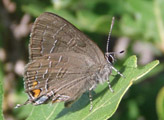Native Plants
Search for native plants by scientific name, common name or family. If you are not sure what you are looking for, try the Combination Search or our Recommended Species lists.
Carya texana
Carya texana Buckley
Black Hickory, Buckley Hickory, Pignut Hickory
Juglandaceae (Walnut Family)
Synonym(s): Carya buckleyi, Carya buckleyi var. arkansana, Carya glabra var. villosa, Carya texana var. arkansana, Carya texana var. villosa, Hicoria arkansana, Hicoria texana, Hicoria villosa
USDA Symbol: CATE9
USDA Native Status: L48 (N)
A small to large tree, depending on habitat. Leaves alternate, pinnately compound, 5-7 leaflets; leaf-scar heart-shaped; bud small, brown, symmetrical; nut slightly four-winged; 2.5-3 cm in diameter.
Plant Characteristics
Duration: PerennialHabit: Tree
Leaf Retention: Deciduous
Leaf Complexity: Pinnate
Breeding System: Flowers Unisexual , Monoecious
Fruit Type: Nut
Size Notes: Up to about 140 feet tall in rich moist bottomlands. Up to about 30 feet tall in shallow, rocky soils.
Bloom Information
Bloom Color: RedBloom Time: Mar
Distribution
USA: AL , AR , GA , IL , IN , KS , KY , LA , MO , MS , OK , TN , TXNative Distribution: S.w. IN, c. IL, MO & s.e. KS, s. to c. OK, Edwards Plateau, s. TX & LA
Native Habitat: Rocky, upland forests; well-drained slopes
Growing Conditions
Water Use: MediumLight Requirement: Part Shade
Soil Moisture: Dry
Soil Description: Variable. Rocky, Sandy, Sandy Loam, Medium Loam, Clay Loam, Clay.
Conditions Comments: One of the most adaptable of all hickories but prefers thinner, well-drained areas. Difficult to transplant because of a large taproot.
Benefit
Use Ornamental: Shade tree, Fall conspicuousUse Wildlife: Substrate-insectivorous birds, Cover, Nesting site, Fruit-birds. Starvation browse for deer; nuts eaten.
Attracts: Butterflies
Larval Host: Serves as a primary host for some magnificent moths, including the luna, funeral dagger, and giant regal. Banded hairstreak.
Butterflies and Moths of North America (BAMONA)
|
Banded Hairstreak (Satyrium calanus)  Larval Host |
Propagation
Propagation Material: SeedsDescription: Most easily grown from fresh seed sown immediately after collection or stratified and sown in spring. Increase by hardwood cuttings is usually successful.
Seed Collection: Collect nuts from September to November. Husks usually dry and split open by themselves when the nuts are mature. Persistent husks can be removed with a corn sheller.
Seed Treatment: Embyro dormancy can be overcome by moist stratification at 33-40 degrees for 30-150 days. Older seeds require less stratification.
Commercially Avail: yes
From the National Organizations Directory
According to the species list provided by Affiliate Organizations, this plant is on display at the following locations:Pineywoods Native Plant Center - Nacogdoches, TX
Stengl Biological Research Station - Smithville, TX
Texas Parks and Wildlife Department - Austin, TX
Texas Master Naturalists - Lost Pines Chapter - Bastrop, TX
Bibliography
Bibref 298 - Field Guide to Texas Trees (1999) Simpson, B.J.Bibref 318 - Native Texas Plants: Landscaping Region by Region (2002) Wasowski, S. & A. Wasowski
Bibref 291 - Texas Wildscapes: Gardening for Wildlife (1999) Damude, N. & K.C. Bender
Bibref 297 - Trees of Central Texas (1984) Vines, Robert A.
Search More Titles in Bibliography
Additional resources
USDA: Find Carya texana in USDA PlantsFNA: Find Carya texana in the Flora of North America (if available)
Google: Search Google for Carya texana
Metadata
Record Modified: 2022-09-20Research By: DEW